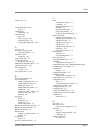
Glossary
Glossary-8
Quality of Service load balancing mode
The Quality of Service load balancing mode is a dynamic load balancing
mode that bases connection distribution on a configurable combination of
the packet rate, completion rate, round trip time, hops, virtual server
capacity, kilobytes per second, and topology information.
ratio
A ratio is the parameter in a virtual server statement that assigns a weight to
the virtual server for load balancing purposes.
Ratio mode
The Ratio load balancing mode is a static load balancing mode that
distributes connections across an pool of virtual servers in proportion to the
ratio weight assigned to each individual virtual server.
receiver 3-DNS
A receiver 3-DNS is a system, in a sync group, that receives metrics data
that are broadcast from big3d agents, but does not initiate metrics collection.
See also principal 3-DNS.
redundant system
A redundant system is a pair of systems that are configured for fail-over. In
a redundant system, one system runs as the active unit and the other system
runs as the standby unit. If the active unit fails, the standby unit takes over
and manages resolution requests.
remote administrative IP address
A remote administrative IP address is an IP address from which a system
allows shell connections, such as SSH, RSH, or Telnet.
resolver
The resolver is the client part of the Domain Name System. The resolver
translates a program's request for host name information into a query to a
name server, and translates the response into an answer to the program's
request. See also name server.
resource record
resource record is a record in a DNS database that stores data associated
with domain names. A resource record typically includes a domain name, a
TTL, a record type, and data specific to that record type. See also A record,
CNAME record, NS record.
reverse domains
A type of DNS resolution request that matches a given IP address to a
domain name. The more common type of DNS resolution request starts with
a given domain name and matches that to an IP address.


















